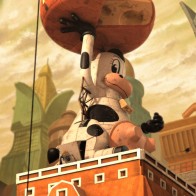 Quicker is not better when it comes from a grocery store chain. The grocery store is one of the many places in America where the illusion of choice is one full blast. A customer may have fifty different brands of cereal, but in realty, one only has two choices, cereal grains or oat grains. And if one breaks those two choices down further, there is only one choice–corn.
Quicker is not better when it comes from a grocery store chain. The grocery store is one of the many places in America where the illusion of choice is one full blast. A customer may have fifty different brands of cereal, but in realty, one only has two choices, cereal grains or oat grains. And if one breaks those two choices down further, there is only one choice–corn.
In The Beacon News, it published an article about suburban supermarket chain Jewel-Osco, a subsidiary of the larger SuperValu Inc, color coding their items to help customers make “quick and easy” choices for their loved ones.
According to the Sun-Times Media offshoot, Jewel-Osco wants it’s valued customers to use the “nutrition iQ” system because the chain wants the community to believe that “our customers are looking for more healthy foods, and this is a quick and easy way for them to make better food choices in the store.”
These recommendations will follow the Food and Drug Administration’s guidelines that encourage Americans to eat less salt and sugar, and increase their fiber intake. The government is continuing to promote itself as a concerned entity when it comes it’s citizens eating patterns, but conversely, it has not discouraged companies from producing the food that has such a negative grip on American’s nutrition.
Despite the supermarket’s claim that their “nutrition iQ” program is “not an advertising gimmick,” anytime one needs a tagging system to differentiate between nutritional dense foods and outright junk food, the question arises if the supermarket is actually the real gimmick, not the food.
I’m sure most Americans know the difference between plain oatmeal and Cinnamon Toast Crunch. But, what maybe tricky is the difference between the small details printed on the back of boxes that scientifically hide the base name for simple produce like corn. Hardly anyone sits in the store and has the wherewithal to look up the derivatives of corn like maltodextrin, monosodium glutamate, or xanthan gum.
There would be no point in color coding the supermarket if they based the system on produce because most of isles would be two colors–yellow for corn and tan for grain.
America’s economy runs on this fundamental principal of illusionary choice in all aspects of life for the precise reason of disarming the citizens from making choices based primarily on critical thinking.
Dietitian Kim Kirchherr, who designed the program, thinks this system will help kids understand what foods are good and which are not, but once kids and parents are both trying to figure out what is nutritionally dense and what is not, we have a clear sign of an epic failure to properly educate people on basic principals of life.
Kids and parents alike can understand how Jewel-Osco’s system is really just a well-mannered, “expert-driven” gimmick, much like the supermarket itself, by asking themselves one question, “Why does the produce section seem to have a natural color coded system and the rest of the supermarket must implement a color coding program?”
The answer is simple: Eat more fruit and vegetables, everything else is a gimmick.




I think this might help for the people who cannot eat enough fruits and vegetables because they don’t make enough money. I agree that supermarkets do more harm than good, but I have no idea what would be the alternative besides Farmer’s Markets?
I’m starting a garden as soon as the winter is over so I don’t have to rely on the grocery store for my food. I have two small children so I cannot help but be concerned about the rising food prices and pesticides in all the food.
Good article Frugivore